Abstract
Background:
Parkinson's disease (PD) is one of the most prevalent neurologic disorders, leading to progressive disability that can be slowed but not stopped by treatment. It is characterized by tremors, slow movements, stiffness in arms and legs, and balance impairment. Despite advancement in treatment, diagnosis, and care of PD patients, lack of adequate knowledge and associated beliefs among the community might have a key role in limiting access to proper treatment and care.
Objectives:
To identify the level of awareness of our population regarding PD in terms of causes, signs, symptoms, and treatment.
Materials and Methods:
A cross-sectional study was conducted on Saudis, who have active Twitter accounts. Data were collected through a previously validated questionnaire, which tests recognition of PD symptoms and general knowledge regarding PD. The questionnaire was translated into Arabic. Part 1 of the questionnaire is the demographic data collection sheet, Part 2 of the questionnaire tests recognition of PD symptoms, and Part 3 of the questionnaire tests general knowledge regarding PD.
Results:
The questionnaire was administered to 3,050 members of the public, of which 2,609 questionnaires (86.20%) were included in the analysis. The tremor was the most widely recognized symptom (86.10%), and weight loss was the most recognized non-motor symptom (24%). Most respondents (56%) were able to identify imbalance as a symptom of PD, whereas only 4.10% of them were able to identify the reduced sense of smell as a symptom of PD. Motor symptoms were significantly better recognized (range 31.30%–86.10%) than non-motor symptoms (range 4.10%–24%).
Conclusion:
Educational campaigns may be appropriate to improve public awareness of PD and individual knowledge about PD symptoms and treatment.
Keywords: Awareness, Parkinson's disease, public
Introduction
Parkinson's disease (PD) is one of the most prevalent neurologic disorders, leading to progressive disability that can be slowed but not stopped by treatment.[1] It is characterized by tremors, slow movements, stiffness in arms and legs, and balance impairment.[2] The prevalence of PD in Saudi Arabia has been estimated to be 27 per 100,000 population.[3]
Health awareness is essential to patient engagement in the healthcare process. A multicenter, prospective observational study reported that delayed treatment of PD may be associated with poorer patient outcomes, possibly because of functional decline may be difficult to reverse.[4]
Similar to other chronic and progressive disabling diseases, PD patients experience stigma arising from symptoms that are impossible to hide, and they experience relational and communicational problems.[5] Few studies concerning PD have been carried out in Saudi Arabia, and to our knowledge, there are no published studies have evaluated community knowledge and attitudes toward PD.[2,6,7]
A study was done in Uganda to assess knowledge toward PD showed that 50.4% of participants did not know the body part related to PD.[8] A study from South Korea concluded that participants between 40 and 59 years of age and who had completed more than 12 years of education showed more awareness of PD compared to younger participants who exhibited the least knowledge. In addition, low socio-economic status is associated with poor knowledge of PD.[9] A study in Malaysia reported that 49.8% of participants believe that there is a cure for PD and 41.4% thought that it is usually familial.[10]
Despite advancement in treatment, diagnosis, and care of PD patients, lack of adequate knowledge and associated beliefs among the community might have a key role in limiting access to proper treatment and care. Understanding community knowledge and beliefs could help to inform care approaches that reduce stigma and promote care seeking.
Materials and methods
A cross-sectional study was conducted on Saudis, who have active Twitter accounts. Data were collected between 15 March 2018 and 15 April 2018. Data were collected through a previously validated questionnaire, which tests recognition of PD symptoms and general knowledge regarding PD [Appendix 1]. The questionnaire was translated into Arabic [Appendix 2]. Part 1 of the questionnaire is the demographic data collection sheet, Part 2 of the questionnaire tests recognition of PD symptoms, and Part 3 of the questionnaire tests general knowledge regarding PD.
The questionnaire was uploaded as a Google form and distributed to Twitter accounts of Saudi celebrities. The celebrities included writers, politicians, TV presenters, sports personnel, and religious leaders. The authors contacted the celebrities to participate in providing a link to their followers for them to fill up; this was done to get a bigger number of Saudi participants.
Twitter is an online news and social networking service, where users post and interact with messages, called “tweets.” These messages are limited to 280 characters. According to statista.com, the number of active Twitter users in Saudi Arabia in 2016 reached five million. As reported by globalwebindex.net, Twitter is the fastest growing social platform in the world.
All Saudis who have active Twitter accounts during the study period were included.
The data acquired from filled forms were entered using Microsoft Excel, and they were exported for analysis to IBM SPSS software. The results were described using descriptive statistics, namely the distribution of frequencies, measures of central tendency (mean), and measures of dispersion (standard deviation).
A request was sent to King Abdullah International Medical Research Center requesting permission to conduct and publish the study, which was approved. Data confidentiality and anonymity were ensured.
Results
The questionnaire was administered to 3,050 members of the public, of which 2,609 questionnaires (86.20%) were included in the analysis. The most common reasons for exclusion were respondents less than 18-year-old and non-Saudis respondents. In total, 291 caregivers completed the questionnaire. General characteristics of the respondents were the mean age of the individuals was 26.13 years (standard deviation: 8.42; minimum: 18 and maximum: 67). Fifty-nine percent (n = 1529) were female. Seventy-four percent of the respondents have a university level of education, and 20.70% of the respondents have a high school level of education. Respondents’ demographics are summarized in Table 1.
Table 1.
Demographic characteristics of respondents
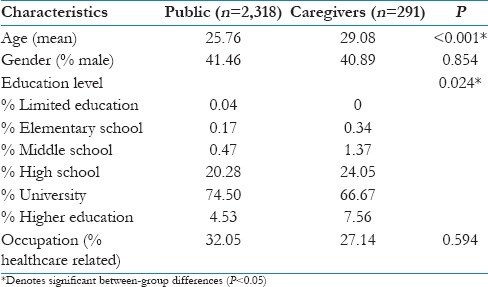
The tremor was the most widely recognized symptom (86.10%), and weight loss was the most recognized non-motor symptom (24%). Most respondents (56%) were able to identify imbalance as a symptom of PD, whereas only 4.10% of them were able to identify a reduced sense of smell as a symptom of PD. Motor symptoms were significantly better recognized (range 31.30%–86.10%) than non-motor symptoms (range 4.10%–24%). Part 2 of the questionnaire, which tests recognition of PD symptoms, is summarized in Figure 1.
Figure 1.
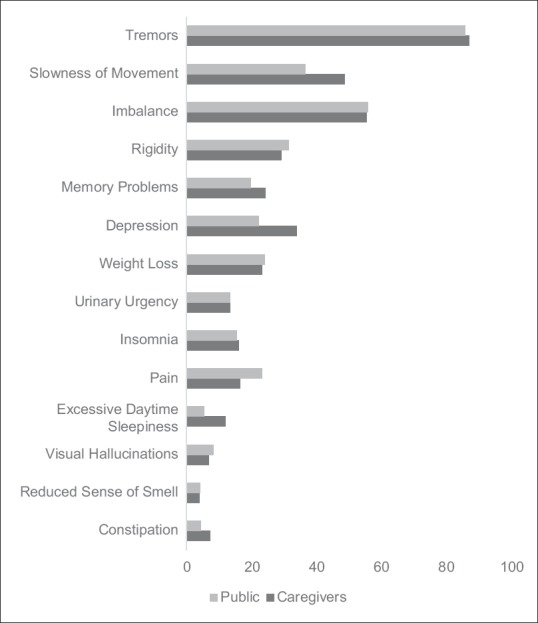
Part 2 of the questionnaire – recognition of PD symptoms. Motor symptoms listed first, followed by non-motor symptoms. Adopted from A.H. et al./Knowledge of Parkinson's Disease
Seventy-nine percent of the respondents answered Statement 4 incorrectly (all patients with PD experience tremor) and 56.65% answered Statement 7 incorrectly (PD usually affects multiple members of the same family). Forty-two percent of the respondents showed misperceptions about Statement 2 (PD is a degenerative disease of the brain) and 25.45% of them showed misperception about Statement 10 (patients with PD often feel socially isolated).
Compared with the public, caregivers for PD were found to have similar rates of correct responses for Statements 1, 4, 6, and 7 of Part 3 of the questionnaire. For Statements 3, 5, 8, 9, and 10, caregivers for PD showed significantly higher rates of correct responses. For Statement 2, the public showed a significantly higher rate of correct responses than the caregivers for PD [Table 2].
Table 2.
Part 3: Rates of true-false statements answered correctly (Public vs. Caregivers)
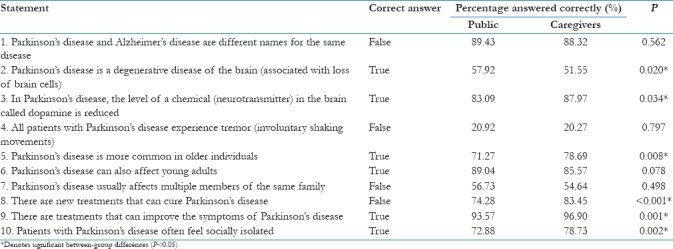
Compared with the public, healthcare workers were found to have similar rates of correct responses for Statements 4, 6, 7, 8, and 9 of Part 2 of the questionnaire. For Statements 1, 3, and 5, healthcare workers showed significantly higher rates of correct responses. For Statement 2 and 10, the public showed a significant higher rate of correct responses [Table 3].
Table 3.
Part 3: Rates of true-false statements answered correctly (Public vs. Healthcare workers)
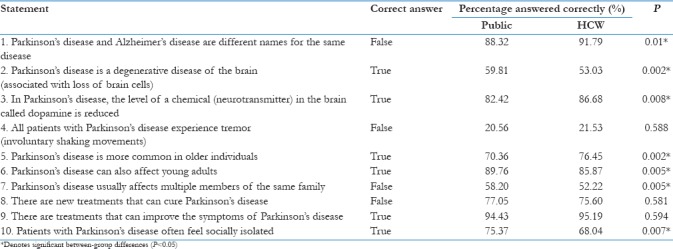
Discussion
To the best of our knowledge, there are no published studies from the Middle East on public awareness of PD. However, there are published studies on this topic from Asia, Europe, USA, and Australia.[6,9,10,11,12,13] In our study, we introduced a previously validated questionnaire to the public (n = 2609). We found the general knowledge of the public was reasonably well with common misperceptions (for example, tremor as the universal feature of PD among 79.15% of respondents). Motor symptoms, which are the defining features of PD, were better recognized than non-motor symptoms. Caregivers to PD demonstrated a similar level of knowledge compared with the public. However, healthcare workers showed superior knowledge than the public. Surprisingly, 79.73% of healthcare workers reported tremor as a universal feature of PD.
Our observation that tremor was the best recognized symptom of PD is unsurprising because tremor is present in 80% of PD patients and it is a highly visible feature of the disease.[14,15] Non-motor symptoms of PD have been under-recognized (as also found in A.H. Tan et al. study). This is in part because non-motor symptoms may be non-specific and misreported to normal aging or comorbidities.
In our study, caring for someone with PD was not associated with a higher level of knowledge of PD. In contrast, A.H. Tan et al. study showed an association between knowing someone with PD and higher level of knowledge of PD. As A.H. Tan et al., our study demonstrated an association between healthcare workers and a higher level of knowledge of PD.
The bias from the recruitment of Twitter, Inc. users could lead to generally more active and healthier study participants. Twitter, Inc. is a very popular social media site worldwide. According to statista.com, Twitter, Inc. has over 335 million active users worldwide (over 5 million in Saudi Arabia). Overall, Twitter, Inc. is used across different age groups and throughout the entire regions of the country.
Conclusion
Educational campaigns may be appropriate to improve public awareness of PD and individual knowledge about PD symptoms and treatment. The finding of our study suggests that educational programs should include information about rest tremor is typical but not stuffiest to diagnose PD, non-motor symptoms are common in PD, and PD is usually sporadic rather than familial.
Financial support and sponsorship
Nil.
Conflicts of interest
There are no conflicts of interest.
Appendix 1: Knowledge of Parkinson's Disease Questionnaire, English-Language Version
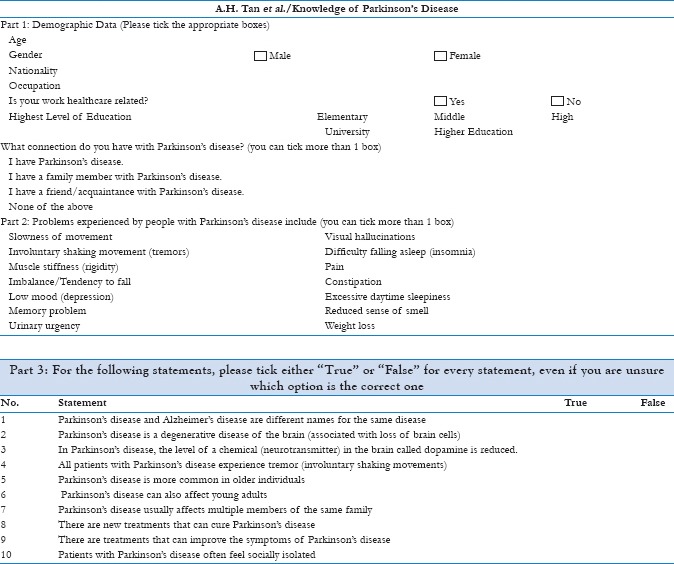
Appendix 2: Knowledge of Parkinson's Disease Questionnaire, Translated into Arabic-Language
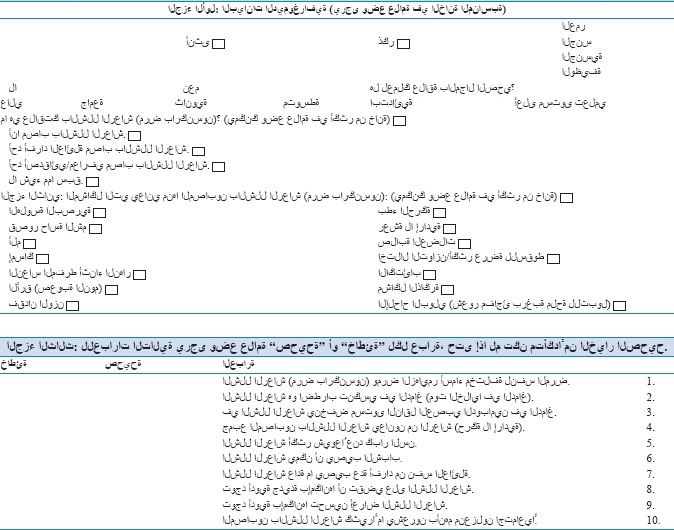
References
- 1.Gonzalez-Usigli H. Parkinson disease - neurologic disorders. MSD Manual Professional Edition. 2017. [Last accessed on 2018 May 15]. Available from: https://www.msdmanuals.com/professional/neurologic-disorders/movement-and-cerebellar-disorders/parkinson-disease .
- 2.Hauser R. Parkinson disease: Practice essentials, background, anatomy. Medscape. 2017. [Last accessed on 2018 May 15]. Available from: http://emedicine.medscape.com/article/1831191-overview .
- 3.Alrajeh S, Bademosi O, Ismail H, Awada A, Dawodu A, al-Freihi H, et al. A community survey of neurological disorders in Saudi Arabia: The Thugbah study. Neuroepidemiology. 1993;12:164–78. doi: 10.1159/000110316. [DOI] [PubMed] [Google Scholar]
- 4.Grosset D, Taurah L, Burn DJ, MacMahon D, Forbes A, Turner K, et al. A multicentre longitudinal observational study of changes in self reported health status in people with Parkinson's disease left untreated at diagnosis. J Neurol Neurosurg Psychiatry. 2007;78:465–9. doi: 10.1136/jnnp.2006.098327. [DOI] [PMC free article] [PubMed] [Google Scholar]
- 5.Maffoni M, Giardini A, Pierobon A, Ferrazzoli D, Frazzitta G. Stigma experienced by Parkinson's disease patients: A descriptive review of qualitative studies. Parkinson's Dis 2017. 2017 doi: 10.1155/2017/7203259. 7203259. Doi: 10.1155/2017/7203259. [DOI] [PMC free article] [PubMed] [Google Scholar]
- 6.Kaddumukasa M, Kakooza A, Kaddumukasa MN, Ddumba E, Mugenyi L, Sajatovic M, et al. Knowledge and attitudes of Parkinson's disease in rural and urban Mukono district, Uganda: A cross-sectional, community-based study. Parkinson's Dis 2015. 2015 doi: 10.1155/2015/196150. 196150. [DOI] [PMC free article] [PubMed] [Google Scholar]
- 7.Al-Mubarak BR, Bohlega SA, Alkhairallah TS, Magrashi AI, AlTurki MI, Khalil DS, et al. Parkinson's disease in Saudi patients: Agenetic study. PLOS One. 2015;10:e0135950. doi: 10.1371/journal.pone.0135950. [DOI] [PMC free article] [PubMed] [Google Scholar]
- 8.Alamri Y, MacAskill M, Anderson T, Benamer H. Parkinson's disease in the Gulf countries: Anupdated review. Eur Neurol. 2015;74:222–5. doi: 10.1159/000442283. [DOI] [PubMed] [Google Scholar]
- 9.Youn J, Oh E, Park J, Park S, Kim JS, Jang W. Public awareness and knowledge about Parkinson's disease: A national population based survey in South Korea. Neuroepidemiology. 2016;47:117–23. doi: 10.1159/000452500. [DOI] [PubMed] [Google Scholar]
- 10.Tan AH, Tan CT, Marras C, Loh KW, Wye Ho NW, Lim QH, et al. Knowledge of Parkinson's disease in a multiethnic urban Asian setting. J Parkinsons Dis. 2015;5:865–79. doi: 10.3233/JPD-150594. [DOI] [PubMed] [Google Scholar]
- 11.Moore S, Knowles S. Beliefs and knowledge about Parkinson's disease. J Appl Psychol. 2006;2:15–21. [Google Scholar]
- 12.Pan S, Stutzbach J, Reichwein S, Lee BK, Dahodwala N. Knowledge and attitudes about Parkinson's disease among a diverse group of older adults. J Cross Cult Gerontol. 2014;29:339–52. doi: 10.1007/s10823-014-9233-x. [DOI] [PMC free article] [PubMed] [Google Scholar]
- 13.European Parkinson's Disease Association (EPDA) Perceptions of Parkinson's disease: Survey executive summary. 2009 [Google Scholar]
- 14.Nutt JG, Wooten GF. Diagnosis and initial management of Parkinson's disease. N Engl J Med. 2015;353:1021–7. doi: 10.1056/NEJMcp043908. [DOI] [PubMed] [Google Scholar]
- 15.Hughes AJ, Ben-Shlomo Y, Daniel SE, Lees AJ. What features improve the accuracy of clinical diagnosis in Parkinson's disease: Aclinicopathologic study. Neurology. 1992;42:1142–6. doi: 10.1212/wnl.42.6.1142. [DOI] [PubMed] [Google Scholar]


